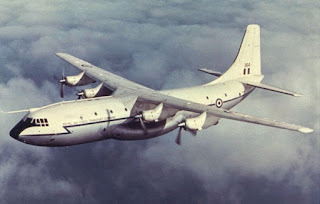The Short Belfast (Shorts Belfast) is a heavy lift turboprop freighter that was built by British manufacturer Short Brothers at Belfast. Only 10 aircraft were constructed, all of which entered service with the Royal Air Force (RAF), who operated it under the designation Short Belfast C.1.
 Upon its entry into service, the Belfast held the distinction of becoming the largest aircraft that the British military had ever operated up to that time. It was also notable for being the first aircraft to be designed from the onset to be equipped with full 'blind landing' automatic landing system equipment. Following the formation of RAF Strike Command and a reorganisation of transport assets, the RAF decided to retire all of its Belfast transports by the end of 1976.
Upon its entry into service, the Belfast held the distinction of becoming the largest aircraft that the British military had ever operated up to that time. It was also notable for being the first aircraft to be designed from the onset to be equipped with full 'blind landing' automatic landing system equipment. Following the formation of RAF Strike Command and a reorganisation of transport assets, the RAF decided to retire all of its Belfast transports by the end of 1976.
Shortly after the type had been retired by the RAF, five Belfasts were sold and placed into civilian service with the cargo airline TAC HeavyLift. These civilian aircraft were used for the charter transport of various goods, including to the RAF. One Belfast is on display at the RAF Museum Cosford. A Belfast formerly operated by Heavylift Cargo is lying abandoned at Cairns Airport in Australia and is the subject of a legal dispute for fees between the airport and the current owner of the aircraft, Flying Tigers.
The Short Belfast was a large heavy-lift strategic transport aircraft. It featured a high-mounted wing, which carried a total of four Rolls-Royce Tyne turboprop engines. According to aerospace publication Flight International, the design of the assemblies of the surfaces of both the tail and wing of the Belfast had been derived from the Bristol Britannia. One of the major changes to the wing was its conversion to a wet wing, which was performed by Canadair. There are few other common elements between the Belfast and the Britannia, although there had been a much greater proportion intended during initial designs for the aircraft.
The fuselage of the Belfast was a relatively conservatively-stressed cylinder of a conventional design. It was developed with a target safe-life of 15,000 pressure cycles, which was fatigued tested using a complete fuselage immersed in a water tank. Fail-safe principles were used in the design of the large side door, rear ramp and door. Rolled Z-sections were used throughout the majority of the fuselage frames and stringers, while box beams are used where the exertion of heavier-than-average loads had been typically anticipated; the structure lacks any use of forgings or machined members. More details
 Upon its entry into service, the Belfast held the distinction of becoming the largest aircraft that the British military had ever operated up to that time. It was also notable for being the first aircraft to be designed from the onset to be equipped with full 'blind landing' automatic landing system equipment. Following the formation of RAF Strike Command and a reorganisation of transport assets, the RAF decided to retire all of its Belfast transports by the end of 1976.
Upon its entry into service, the Belfast held the distinction of becoming the largest aircraft that the British military had ever operated up to that time. It was also notable for being the first aircraft to be designed from the onset to be equipped with full 'blind landing' automatic landing system equipment. Following the formation of RAF Strike Command and a reorganisation of transport assets, the RAF decided to retire all of its Belfast transports by the end of 1976.Shortly after the type had been retired by the RAF, five Belfasts were sold and placed into civilian service with the cargo airline TAC HeavyLift. These civilian aircraft were used for the charter transport of various goods, including to the RAF. One Belfast is on display at the RAF Museum Cosford. A Belfast formerly operated by Heavylift Cargo is lying abandoned at Cairns Airport in Australia and is the subject of a legal dispute for fees between the airport and the current owner of the aircraft, Flying Tigers.
The Short Belfast was a large heavy-lift strategic transport aircraft. It featured a high-mounted wing, which carried a total of four Rolls-Royce Tyne turboprop engines. According to aerospace publication Flight International, the design of the assemblies of the surfaces of both the tail and wing of the Belfast had been derived from the Bristol Britannia. One of the major changes to the wing was its conversion to a wet wing, which was performed by Canadair. There are few other common elements between the Belfast and the Britannia, although there had been a much greater proportion intended during initial designs for the aircraft.